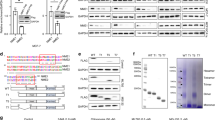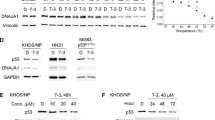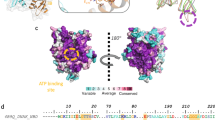Abstract
Heat shock protein 90 (Hsp90) is a molecular chaperone that maintains function of numerous intracellular signaling nodes utilized by cancer cells for proliferation and survival. Hsp90 is also detected on the plasma membrane of tumor cells and its expression has been suggested to correlate with metastatic potential. Given the abundance and diverse functions of the intracellular pool of this protein, the precise contribution of cell surface Hsp90 to cell motility and tumor metastasis remains to be determined. In this study we utilized the small molecule DMAG-N-oxide, a novel cell-impermeable Hsp90 inhibitor, to specifically examine the role of cell surface Hsp90 in cell motility. We observed that, while not affecting intracellular Hsp90 function, DMAG-N-oxide significantly retarded tumor cell migration and integrin/extracellular matrix-dependent cytoskeletal reorganization. Concomitant with these findings, targeting cell surface Hsp90 significantly inhibited tumor cell motility and invasion in vitro, and had a dramatic impact on melanoma cell lung colonization in vivo. These data indicate that cell surface Hsp90 plays an important role in modulating cancer cell migration that is independent of the function of the intracellular Hsp90 pool, and that small molecule inhibitors of surface Hsp90 may provide a new approach to targeting the metastatic phenotype.
This is a preview of subscription content, access via your institution
Access options
Subscribe to this journal
Receive 50 print issues and online access
$259.00 per year
only $5.18 per issue
Buy this article
- Purchase on Springer Link
- Instant access to full article PDF
Prices may be subject to local taxes which are calculated during checkout





Similar content being viewed by others
References
Arlander SJ, Felts SJ, Wagner JM, Stensgard B, Toft DO, Karnitz LM . (2006). Chaperoning checkpoint kinase 1 (Chk1), an Hsp90 client, with purified chaperones. J Biol Chem 281: 2989–2998.
Banerji U, Walton M, Raynaud F, Grimshaw R, Kelland L, Valenti M et al. (2005). Pharmacokinetic-pharmacodynamic relationships for the heat shock protein 90 molecular chaperone inhibitor 17-allylamino, 17-demethoxygeldanamycin in human ovarian cancer xenograft models. Clin Cancer Res 11: 7023–7032.
Becker B, Multhoff G, Farkas B, Wild PJ, Landthaler M, Stolz W et al. (2004). Induction of Hsp90 protein expression in malignant melanomas and melanoma metastases. Exp Dermatol 13: 27–32.
Brunson KW, Beattie G, Nicolsin GL . (1978). Selection and altered properties of brain-colonising metastatic melanoma. Nature 272: 543–545.
Cranmer LD, Trevor KT, Bandlamuri S, Hersh EM . (2005). Rodent models of brain metastasis in melanoma. Melanoma Res 15: 325–356.
Entschladen F, Drell TLt, Lang K, Joseph J, Zaenker KS . (2004). Tumour-cell migration, invasion, and metastasis: navigation by neurotransmitters. Lancet Oncol 5: 254–258.
Erkeller-Yuksel FM, Isenberg DA, Dhillon VB, Latchman DS, Lydyard PM . (1992). Surface expression of heat shock protein 90 by blood mononuclear cells from patients with systemic lupus erythematosus. J Autoimmun 5: 803–814.
Eustace BK, Sakurai T, Stewart JK, Yimlamai D, Unger C, Zehetmeier C et al. (2004). Functional proteomic screens reveal an essential extracellular role for hsp90 alpha in cancer cell invasiveness. Nat Cell Biol 6: 507–514.
Fidler IJ . (1973). Selection of successive tumour lines for metastasis. Nat New Biol 242: 148–149.
Fidler IJ . (1999). Critical determinants of cancer metastasis: rationale for therapy. Cancer Chemother Pharmacol 43: S3–S10.
Heath EI, Gaskins M, Pitot HC, Pili R, Tan W, Marschke R et al. (2005). A phase II trial of 17-allylamino-17-demethoxygeldanamycin in patients with hormone-refractory metastatic prostate cancer. Clin Prostate Cancer 4: 138–141.
Munster PN, Srethapakdi M, Moasser MM, Rosen N . (2001). Inhibition of heat shock protein 90 function by ansamycins causes the morphological and functional differentiation of breast cancer cells. Cancer Res 61: 2945–2952.
Neckers L . (2002). Hsp90 inhibitors as novel cancer chemotherapeutic agents. Trends Mol Med 8: S55–S61.
Neckers L, Neckers K . (2005). Heat-shock protein 90 inhibitors as novel cancer chemotherapeutics—an update. Expert Opin Emerg Drugs 10: 137–149.
Nguyen DM, Desai S, Chen A, Weiser TS, Schrump DS . (2000). Modulation of metastasis phenotypes of non-small cell lung cancer cells by 17-allylamino 17-demethoxy geldanamycin. Ann Thorac Surg 70: 1853–1860.
Owen BA, Sullivan WP, Felts SJ, Toft DO . (2002). Regulation of heat shock protein 90 ATPase activity by sequences in the carboxyl terminus. J Biol Chem 277: 7086–7091.
Schlaepfer DD, Hauck CR, Sieg DJ . (1999). Signaling through focal adhesion kinase. Prog Biophys Mol Biol 71: 435–478.
Schlaepfer DD, Mitra SK, Ilic D . (2004). Control of motile and invasive cell phenotypes by focal adhesion kinase. Biochim Biophys Acta 1692: 77–102.
Sidera K, Samiotaki M, Yfanti E, Panayotou G, Patsavoudi E . (2004). Involvement of cell surface HSP90 in cell migration reveals a novel role in the developing nervous system. J Biol Chem 279: 45379–45388.
Solit DB, Zheng FF, Drobnjak M, Munster PN, Higgins B, Verbel D et al. (2002). 17-Allylamino-17-demethoxygeldanamycin induces the degradation of androgen receptor and HER-2/neu and inhibits the growth of prostate cancer xenografts. Clin Cancer Res 8: 986–993.
Stellas D, Karameris A, Patsavoudi E . (2007). Monoclonal antibody 4C5 immunostains human melanomas and inhibits melanoma cell invasion and metastasis. Clin Cancer Res 13: 1831–1838.
Tian ZQ, Liu Y, Zhang D, Wang Z, Dong SD, Carreras CW et al. (2004). Synthesis and biological activities of novel 17-aminogeldanamycin derivatives. Bioorg Med Chem 12: 5317–5329.
Wehrle-Haller B, Imhof BA . (2003). Actin, microtubules and focal adhesion dynamics during cell migration. Int J Biochem Cell Biol 35: 39–50.
Whitesell L, Bagatell R, Falsey R . (2003). The stress response: implications for the clinical development of hsp90 inhibitors. Curr Cancer Drug Targets 3: 349–358.
Wozniak MA, Modzelewska K, Kwong L, Keely PJ . (2004). Focal adhesion regulation of cell behavior. Biochim Biophys Acta 1692: 103–119.
Wu JC, Sundaresan G, Iyer M, Gambhir SS . (2001). Noninvasive optical imaging of firefly luciferase reporter gene expression in skeletal muscles of living mice. Mol Ther 4: 297–306.
Xu W, Mimnaugh E, Rosser MF, Nicchitta C, Marcu M, Yarden Y et al. (2001). Sensitivity of mature Erbb2 to geldanamycin is conferred by its kinase domain and is mediated by the chaperone protein Hsp90. J Biol Chem 276: 3702–3708.
Yamaguchi H, Wyckoff J, Condeelis J . (2005). Cell migration in tumors. Curr Opin Cell Biol 17: 559–564.
Yamazaki D, Kurisu S, Takenawa T . (2005). Regulation of cancer cell motility through actin reorganization. Cancer Sci 96: 379–386.
Author information
Authors and Affiliations
Corresponding author
Additional information
Supplementary Information accompanies the paper on the Oncogene website (http://www.nature.com/onc).
Rights and permissions
About this article
Cite this article
Tsutsumi, S., Scroggins, B., Koga, F. et al. A small molecule cell-impermeant Hsp90 antagonist inhibits tumor cell motility and invasion. Oncogene 27, 2478–2487 (2008). https://doi.org/10.1038/sj.onc.1210897
Received:
Revised:
Accepted:
Published:
Issue Date:
DOI: https://doi.org/10.1038/sj.onc.1210897
Keywords
This article is cited by
-
Heat shock protein paradigms in cancer progression: future therapeutic perspectives
3 Biotech (2024)
-
Co-targeting HSP90 alpha and CDK7 overcomes resistance against HSP90 inhibitors in BCR-ABL1+ leukemia cells
Cell Death & Disease (2023)
-
Expression of membrane Hsp90 is a molecular signature of T cell activation
Scientific Reports (2022)
-
Four-protein model for predicting prognostic risk of lung cancer
Frontiers of Medicine (2022)
-
Heat Shock Protein 90α Provides an Effective and Novel Diagnosis Strategy for Nasopharyngeal Carcinoma
Advances in Therapy (2021)



